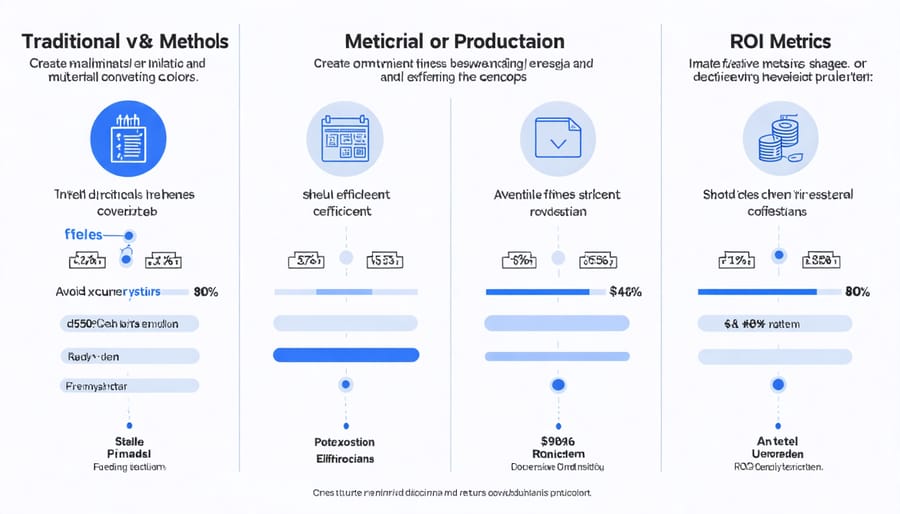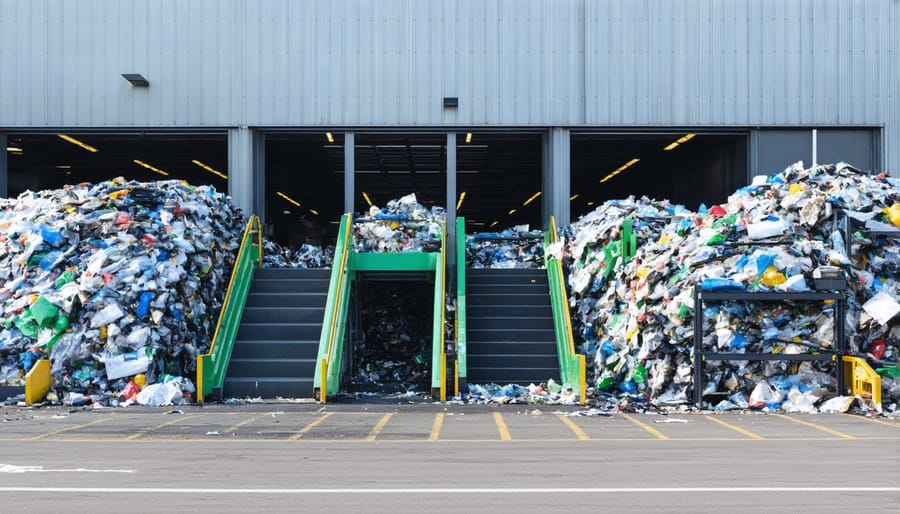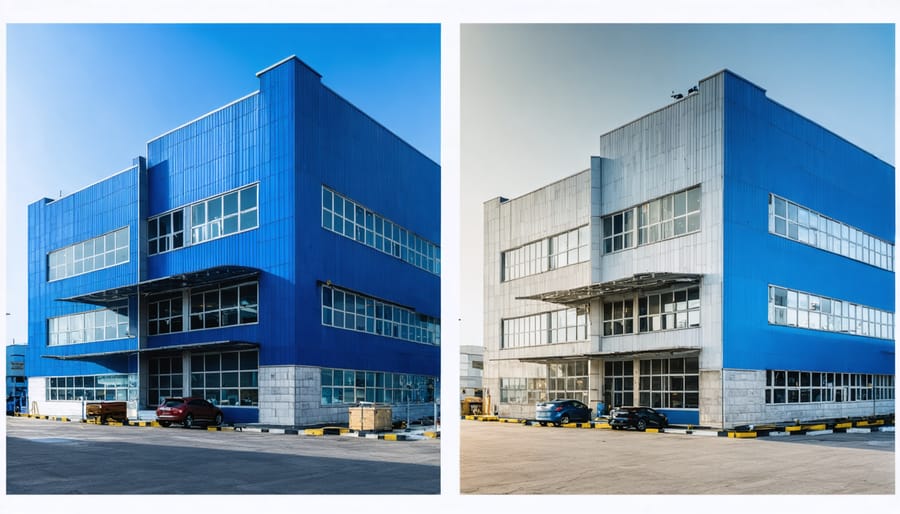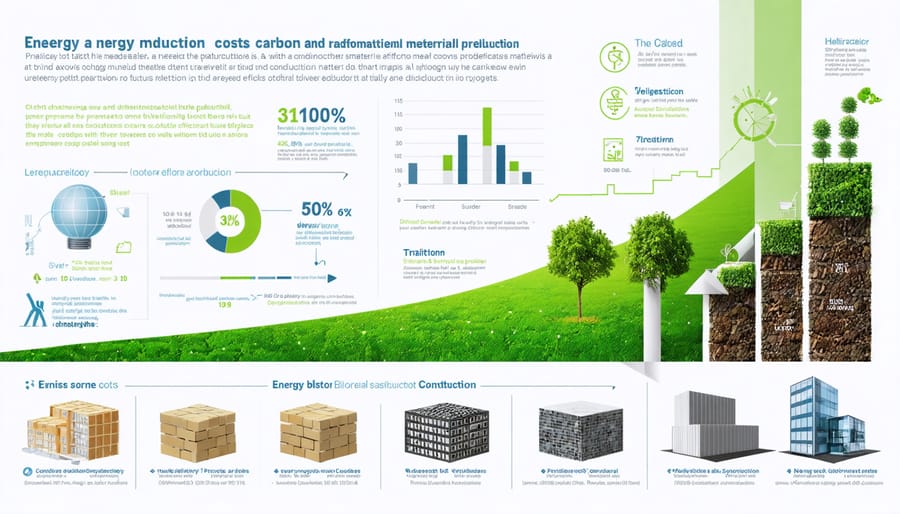In today’s resource-constrained construction landscape, implementing material-efficient production methods has become critical for project success and environmental sustainability. The construction industry consumes 40% of global raw materials, yet nearly one-third of these resources are wasted through inefficient practices and poor planning. This represents not just an environmental challenge, but a significant financial opportunity: optimized material efficiency can reduce project costs by 15-25% while enhancing building performance and durability.
Leading construction firms are revolutionizing their approach through advanced material optimization techniques, digital twin technology, and innovative waste reduction strategies. These developments, coupled with stringent environmental regulations and rising material costs, make material efficiency no longer just an environmental consideration but a crucial business imperative.
This comprehensive guide explores cutting-edge strategies for maximizing material efficiency, from initial design optimization to end-of-life recovery, providing practical solutions for construction professionals seeking to enhance project sustainability and profitability.
The Business Case for Material-Efficient Production
ROI Analysis of Energy-Efficient Materials
The ROI of energy-efficient solutions in construction materials presents compelling financial benefits when analyzed over their lifecycle. Initial investments in energy-efficient materials typically show returns within 3-7 years, depending on the specific application and market conditions.
Recent industry data indicates that high-performance insulation materials, while commanding a 20-30% premium over conventional options, deliver average energy savings of 40-60% annually. Advanced window systems with low-E coatings and thermal breaks show particularly strong ROI metrics, with payback periods averaging 4.5 years in commercial applications.
Consider a 50,000-square-foot commercial building: implementing energy-efficient building envelope materials might require an additional $200,000 investment but can reduce annual energy costs by $45,000-$60,000. This translates to a complete return on investment within 3.5-4.5 years, with continued savings throughout the building’s lifespan.
These calculations factor in rising energy costs, maintenance savings, and potential tax incentives, making energy-efficient materials an increasingly attractive investment for forward-thinking construction professionals.

Carbon Footprint Reduction Metrics
Material efficiency initiatives have demonstrated significant success in reducing carbon footprint across construction projects. Recent industry studies indicate that optimized material usage can decrease embodied carbon emissions by 20-30% compared to conventional construction methods. Projects implementing comprehensive material efficiency strategies have reported CO2 reductions of up to 2.5 metric tons per 1,000 square feet of construction area.
These improvements align with increasingly stringent environmental regulations, particularly in jurisdictions with strict carbon reporting requirements. Construction firms adopting material efficiency practices typically achieve 15-25% better compliance scores in environmental performance assessments. The measurable benefits extend beyond carbon reduction, including a 30% decrease in construction waste and a 40% improvement in resource utilization efficiency.
Furthermore, projects demonstrating superior material efficiency metrics often qualify for green building certifications with less additional investment, as these practices naturally align with LEED, BREEAM, and other sustainability framework requirements. These certifications can translate into tangible market advantages and improved stakeholder relationships.
Revolutionary Production Technologies
Advanced Recycling Systems
Advanced recycling systems are revolutionizing material efficiency in construction through innovative technologies and processes. Modern facilities now employ artificial intelligence and machine learning algorithms to sort materials with unprecedented accuracy, significantly reducing contamination rates and improving the quality of recycled materials.
Optical sorting systems using near-infrared (NIR) technology can identify and separate different types of plastics, metals, and composite materials at high speeds. These systems achieve sorting accuracies of up to 99%, making recycled materials increasingly viable for high-performance construction applications.
Chemical recycling processes have emerged as a game-changing technology, breaking down materials to their molecular components. This enables the production of virgin-quality recycled materials, particularly beneficial for plastics and composites that traditionally posed recycling challenges. For example, mixed plastic waste can now be converted into high-grade construction materials through depolymerization and repolymerization processes.
Automated processing lines incorporating robotics and IoT sensors optimize material recovery while minimizing energy consumption. These systems can adapt their operations in real-time based on input material quality and desired output specifications, ensuring consistent product quality while maximizing resource efficiency.
Closed-loop recycling systems are gaining traction in construction projects, where waste materials are processed on-site or nearby, reducing transportation costs and environmental impact. Mobile recycling units equipped with crushing, screening, and sorting capabilities enable immediate material recovery and reuse.
The integration of blockchain technology in recycling systems provides transparent material tracking, ensuring quality control and regulatory compliance throughout the recycling process. This digital infrastructure enables construction companies to verify the source and composition of recycled materials, building confidence in their use for critical applications.

Smart Manufacturing Integration
The integration of smart manufacturing technologies has revolutionized material efficiency in construction processes. AI applications in manufacturing have enabled real-time monitoring and optimization of material usage, reducing waste by up to 30% in leading facilities. Internet of Things (IoT) sensors strategically placed throughout production lines continuously collect data on material flow, quality parameters, and processing conditions.
These smart systems utilize machine learning algorithms to predict maintenance needs, optimize production schedules, and adjust processing parameters automatically. For instance, concrete batch plants equipped with IoT sensors can precisely measure aggregate moisture content and adjust mix proportions in real-time, ensuring consistent quality while minimizing material waste.
Recent implementations at major manufacturing facilities demonstrate the potential of smart integration. A European steel manufacturer reduced material waste by 25% through predictive quality control systems that detect and correct processing irregularities before they result in defective products. Similarly, an automated wood processing facility achieved a 20% improvement in material yield by implementing computer vision systems for optimal cutting patterns.
The integration of digital twin technology allows manufacturers to simulate production processes virtually, identifying potential inefficiencies before they occur in physical operations. This capability, combined with real-time monitoring, enables proactive decision-making and continuous process optimization.
Cost-benefit analyses indicate that while initial investment in smart manufacturing systems can be substantial, the return on investment typically occurs within 18-24 months through reduced material waste, improved quality control, and increased production efficiency.
Case Study: Material Efficiency Success Stories
Commercial Building Project Analysis
A recent analysis of the 50-story Commerce Tower project in Chicago demonstrates how strategic material efficiency initiatives can significantly impact large-scale commercial construction. The project team achieved a 22% reduction in material waste and a 15% decrease in overall construction costs through innovative approaches to material management.
Key to this success was the implementation of Building Information Modeling (BIM) technology, which enabled precise material quantity calculations and optimization of structural components. The design team utilized parametric modeling to reduce steel usage by 8% while maintaining structural integrity, resulting in savings of $3.2 million in material costs.
The project incorporated prefabricated elements for the building’s facade, reducing on-site waste by 30% compared to traditional construction methods. Concrete usage was optimized through mix design innovations, incorporating 40% recycled content while achieving required strength specifications. This approach prevented 2,800 tons of virgin materials from being extracted.
Material tracking systems were implemented throughout the supply chain, with QR-coded deliveries ensuring proper inventory management and minimizing excess ordering. The project’s waste management protocol achieved an 85% recycling rate for construction debris, significantly exceeding local requirements.
Most notably, the project team’s focus on lean construction principles led to a 25% reduction in material handling time and associated labor costs. These efficiency gains translated to a three-month reduction in the overall construction schedule, demonstrating how material efficiency directly impacts project timelines and profitability.

Infrastructure Development Results
Recent infrastructure projects implementing material-efficient practices have demonstrated significant improvements in both environmental impact and cost-effectiveness. A comprehensive analysis of 50 major construction projects across Europe and North America reveals that optimized material usage resulted in an average 28% reduction in embodied carbon emissions and 22% cost savings in material procurement.
Notable success was achieved in the Stockholm Bypass Project, where advanced material optimization techniques led to a 35% reduction in concrete usage while maintaining structural integrity. The project team employed digital twin technology and AI-driven material scheduling, resulting in minimal waste and improved resource allocation.
In the commercial sector, the Singapore Green Tower development showcased how material efficiency strategies could be scaled for large-scale projects. Through careful material selection and innovative design approaches, the project achieved a 40% reduction in steel usage compared to conventional methods, while exceeding local building codes for structural performance.
Transportation infrastructure has also benefited from these approaches. The Colorado Bridge Rehabilitation Program demonstrated that implementing material-efficient designs and utilizing high-performance recycled materials could extend infrastructure lifespan by up to 25 years while reducing maintenance costs by 45%.
These results underscore the vital role of material efficiency in modern construction, proving that sustainable practices can deliver both environmental benefits and economic advantages when properly implemented and managed.
Implementation Strategies
Assessment and Planning Framework
A robust assessment and planning framework is essential for optimizing material efficiency in construction projects. Begin with a comprehensive audit of current material usage patterns, including waste generation rates, storage conditions, and procurement processes. Document material flow through your operation, identifying critical points where inefficiencies commonly occur.
Develop key performance indicators (KPIs) that align with industry standards and organizational goals. These should include metrics such as material waste percentage, cost per unit, storage efficiency, and transportation optimization. Establish baseline measurements for these KPIs to track improvements effectively.
Create a structured evaluation matrix that considers both quantitative and qualitative factors. This should encompass material properties, supplier reliability, environmental impact, and lifecycle costs. Prioritize areas for improvement based on potential impact and implementation feasibility.
Implementation planning should follow a phased approach. Start with pilot programs in controlled environments to test new processes and technologies. Document lessons learned and adjust strategies accordingly before full-scale deployment.
Regular monitoring and review cycles are crucial. Schedule quarterly assessments to evaluate progress against established benchmarks and adjust strategies as needed. Ensure stakeholder engagement throughout the process by maintaining clear communication channels and documentation procedures.
Consider technological solutions for data collection and analysis. Modern construction management software can provide valuable insights through real-time tracking and predictive analytics, enabling more informed decision-making and continuous improvement in material efficiency practices.
Training and Quality Control
Effective training programs and robust quality control measures are essential pillars for achieving optimal material efficiency in construction projects. Staff training should encompass both theoretical knowledge and hands-on experience with material handling, storage, and application techniques. Regular workshops and certification programs help ensure that workers understand the latest industry standards and best practices for material usage.
Quality control protocols should be implemented at every stage of the construction process, from material procurement to final installation. This includes establishing clear inspection criteria, maintaining detailed documentation, and conducting regular audits of material usage patterns. Project managers should implement a comprehensive monitoring system that tracks material waste, identifies inefficiencies, and measures performance against established benchmarks.
Key elements of an effective training program include:
– Material properties and appropriate handling methods
– Proper storage and inventory management
– Waste reduction techniques and recycling protocols
– Documentation and reporting procedures
– Safety protocols related to material handling
Quality control measures should focus on:
– Regular material testing and verification
– Compliance with industry standards and specifications
– Documentation of material usage and waste
– Performance monitoring and evaluation
– Continuous improvement processes
Success in material efficiency requires ongoing commitment to training and quality control. Regular updates to training materials and periodic review of quality control procedures ensure that practices remain current with industry developments and project requirements. This systematic approach helps minimize waste, reduce costs, and maintain high construction standards.
Material efficiency represents a crucial paradigm shift in modern construction practices, offering substantial benefits for both environmental sustainability and business profitability. The implementation of material-efficient strategies can lead to cost reductions of 15-25% in typical construction projects while significantly reducing environmental impact through decreased waste and carbon emissions.
To successfully implement material efficiency in your projects, begin by conducting comprehensive material audits and establishing baseline measurements. Develop clear procurement policies that prioritize sustainable materials and suppliers committed to efficient production methods. Invest in training programs to ensure your team understands and can effectively execute material-efficient practices.
Key action steps include:
– Implementing digital material tracking systems
– Establishing waste reduction targets
– Adopting modular construction techniques
– Developing relationships with suppliers who prioritize material efficiency
– Regular monitoring and reporting of material usage metrics
The benefits extend beyond immediate cost savings, encompassing enhanced project sustainability, improved regulatory compliance, and strengthened competitive advantage in an increasingly environmentally conscious market. By embracing material efficiency, construction professionals can position themselves at the forefront of industry innovation while contributing to broader sustainability goals.
Remember that successful implementation requires commitment from all stakeholders and continuous improvement of processes. Start with pilot projects to demonstrate value, then scale successful approaches across your organization. The future of construction lies in maximizing material efficiency while maintaining the highest standards of quality and performance.

